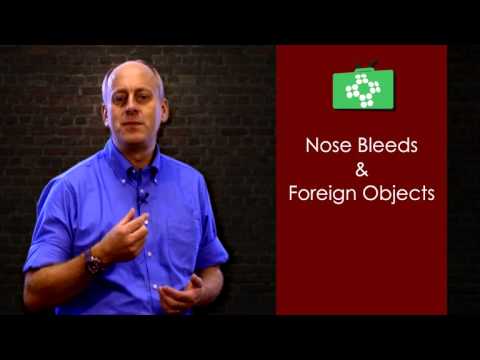Nosebleeds are common in children and adults. They are often easily treated and do not return. Nosebleeds can be distressing to children and embarrassing to adults.
Blood vessels in the nose are close to the skin and easily damaged by putting things in the nose, as well as stress and illness. Nose bleeds can also be from physical impact to the nose by falling or being hit in the face. Be careful when stopping the nose bleed if you think the nose may be broken or if there are any external injuries. Treatment of someone with a nose bleed is first to get them to sit down. If needed, calm and reassure them.
Lean them forward to maintain airway and to prevent blood flowing down the throat which could induce vomiting or nausea. Get them to pinch the soft part of the nose to help stop the bleed and allow the blood flow to stop. You may want to give them a bowl so they can spit out blood rather than swallow if needed and give them tissues.
Leave the pressure on for ten minutes the gently remove the pressure to see if the bleed has stopped.
If it has not stopped, repeat with another ten minutes. If the bleed has not stopped in 30 minutes then you will need to take them to a medical professional. Tell them to avoid sniffing, coughing, blowing nose or talking as these can all cause the bleed to start again and prevent healing.
Regular nose bleeds, may be an indication of something more serious and a visit to a Doctor is advised. Children who suffer from regular nosebleeds, often out grow them without medical treatment.
Children often push items in their ears and up their noses. Other small items can be lodged in the ears or nose and cause injury. Sometimes the item causes no pain others are painful but both can be distressing to the child and parent.
Inside the ears is where our balance is controlled so when an object is lodged in the ear balance and nausea can occur as we’ll as hearing loss and pain. It is very hard to remove an item in the ear as you easily push it so the advice is to seek medical assistance so it can be removed correctly.
There is a possible exception to this advice, where an insect enters the ear. If this happens you can tilt the head so the affected ear is facing up, and carefully pour water in the ear which can float the insect out. If this does not work, seek medical assistance.
Items in the nose will restrict breathing and again can be painful and distressing. If something is stuck in the nose you must get medical assistance as if you try to remove it you will not only push it further in but also do more damage. There are lots of blood vessels close the he skin in the nose and these can easily be damaged causing bleeding.
With both the ears and the nose, try to reassure the child at all time and transport to a doctor or hospital.


